
Under the announced arrangement, the BJP and Janata Dal will both contest 101 seats each, while Chirag Paswan’s Lok Janshakti Party secures 29. The allocation marks a rare parity between BJP and JD, a departure from previous arrangements, but the discontent among smaller partners threatens to strain the alliance’s unity.
Manjhi, who has publicly accepted the assignment, also cautioned of possible “repercussions” if HAM continues to feel undervalued. At a press interaction, he said the party takes instruction from high command, yet lamented the allocation suggests HAM’s role may be sidelined. Kushwaha, for his part, expressed disappointment more pointedly, appealing to supporters for patience but signalling that time would expose the deal’s shortcomings.
The dissent comes even as BJP and JD leaders emphasise that parity is a strategic decision to present balance and prevent infighting. According to a BJP insider, the LJP partner was awarded more seats than originally planned — from a starting offer of around 20 seats up to 29 — for the sake of alliance cohesion. The move to equal split between BJP and JD is unprecedented in the coalition’s history.
Political observers note the revolt underscores broader structural inequities within multi-party coalitions, where major partners often dominate seat shares at the expense of smaller players. The perception of tokenism can sow deeper rifts ahead of elections. With voting scheduled for November 6 and 11, alliance cohesion remains critical.
Opposition voices seized on the discord, with RJD spokespersons claiming the move signals that BJP intends to marginalise JD after polls by first elevating minor allies and then sidelining regional partners. Meanwhile, within HAM, murmurs persist of internal discontent — some party members privately question whether backing will endure if performance in allotted constituencies is not backed by adequate support.
The spotlight now shifts to how the parties will manage fallout from this arrangement. Will concessions emerge through backdoor bargaining? Can the coalition maintain a united front when campaigning intensifies? As election day approaches, the resilience of the NDA’s internal architecture will be tested.
